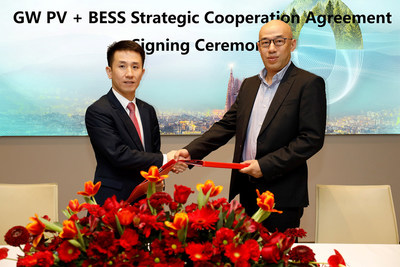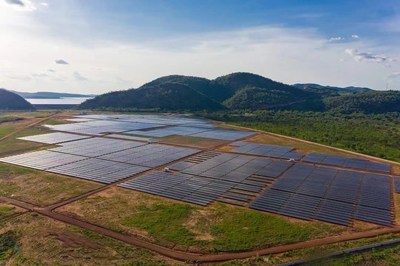World-first solution will combine two power quality technologies to deliver renewable energy reliably and safely from the mainland power grid
Zurich, Switzerland, March 07, 2022 (GLOBE NEWSWIRE) — Hitachi Energy, the global technology and market leader in power grids, announced today that it has been selected by Aker BP, the Norwegian oil and gas exploration and production company, as technology partner for the NOAKA power-from-shore project off the Norwegian coast. The entire project will be powered by up to 150 megawatts of power from the mainland grid – making it the world’s longest power-from-shore AC connection at around 250 km.
Hitachi Energy will perform detailed front-end engineering and design (FEED) studies for a power quality solution that will enable the Aker BP operated NOA Fulla field and the Equinor operated Krafla field in the North Sea to be powered from the mainland. The contract awarded to Hitachi Energy includes an option to deliver the power quality solution when the FEED studies are completed.
By using power from the mainland grid, which is mainly renewable hydropower, minimizes NOAKA’s carbon footprint. To ensure the smooth, reliable and safe transmission of electricity to the offshore platforms, Hitachi Energy’s solution combines two power quality technologies that have never been used before for this type of application: a high-performance STATCOM, called SVC Light®, and thyristor-controlled series capacitors. The MACH™ control and protection system, will enable the two technologies to work in harmony as a single synchronized solution. This will be made possible by leveraging Hitachi Energy’s extensive and unique know-how in power quality solutions as well as its domain integration capabilities.
“We are delighted that Aker BP has selected our pioneering power quality solution, enabling this vital energy project to be powered with emission-free renewable energy,” says Niklas Persson, Managing Director of Hitachi Energy’s Grid Integration business. “This world-first solution will also enable progress toward mega-scale offshore renewable power installations, offering viable alternative pathways for connecting power from shore with AC over long distances.”
“Our ambition is to develop the NOAKA area with a minimum carbon footprint and a prerequisite for this is that the fields are supplied with power-from-shore,” says Lars Høier, Senior Vice President and Asset Manager for NOAKA at Aker BP. “We selected Hitachi Energy as our trusted technology partner to provide a reliable and flexible grid connection and power quality solution to secure high reliability in our operations.”
Hitachi Energy’s proposed solution comprises a new grid connection to house the STATCOM, thyristor-controlled series capacitors, shunt reactors and gas-insulated switchgear. The solution will also increase the transmission capacity of an existing 420 kV mainland grid connection with new gas-insulated switchgear and a power transformer. These are all technologies made by Hitachi Energy to secure exceptional levels of grid availability and reliability.
Hitachi Energy: proven track record in long-distance power-from-shore
Hitachi Energy supplied the world’s first long-distance power-from-shore installation in Norway in 2005 using its HVDC Light® high-voltage direct current technology. Since then, Hitachi Energy has supplied four of the five HVDC power-from-shore installations, all of which supply platforms off the Norwegian coast. In December 2021, Hitachi Energy won a contract to supply the most powerful power-from-shore solution in the Middle East and North Africa. The solution will deliver 3,200 MW of low-carbon power to two offshore production clusters, reducing the clusters’ emissions by up to 35 percent.
About Hitachi Energy Ltd.
Hitachi Energy is a global technology leader that is advancing a sustainable energy future for all. We serve customers in the utility, industry and infrastructure sectors with innovative solutions and services across the value chain. Together with customers and partners, we pioneer technologies and enable the digital transformation required to accelerate the energy transition towards a carbon-neutral future. We are advancing the world’s energy system to become more sustainable, flexible and secure whilst balancing social, environmental and economic value. Hitachi Energy has a proven track record and unparalleled installed base in more than 140 countries. Headquartered in Switzerland, we employ around 38,000 people in 90 countries and generate business volumes of approximately $10 billion USD.
About Hitachi, Ltd.
Hitachi, Ltd. (TSE: 6501), headquartered in Tokyo, Japan, contributes to a sustainable society with a higher quality of life by driving innovation through data and technology as the Social Innovation Business. Hitachi is focused on strengthening its contribution to the Environment, the Resilience of business and social infrastructure as well as comprehensive programs to enhance Security & Safety. Hitachi resolves the issues faced by customers and society across six domains: IT, Energy, Mobility, Industry, Smart Life and Automotive Systems through its proprietary Lumada solutions. The company’s consolidated revenues for fiscal year 2020 (ended March 31, 2021) totaled 8,729.1 billion yen ($78.6 billion), with 871 consolidated subsidiaries and approximately 350,000 employees worldwide. For more information on Hitachi, please visit the company’s website at https://www.hitachi.com.
Attachment

Rebecca Bleasdale Hitachi Energy Ltd. +41 78643 2613 rebecca.bleasdale@hitachienergy.com

